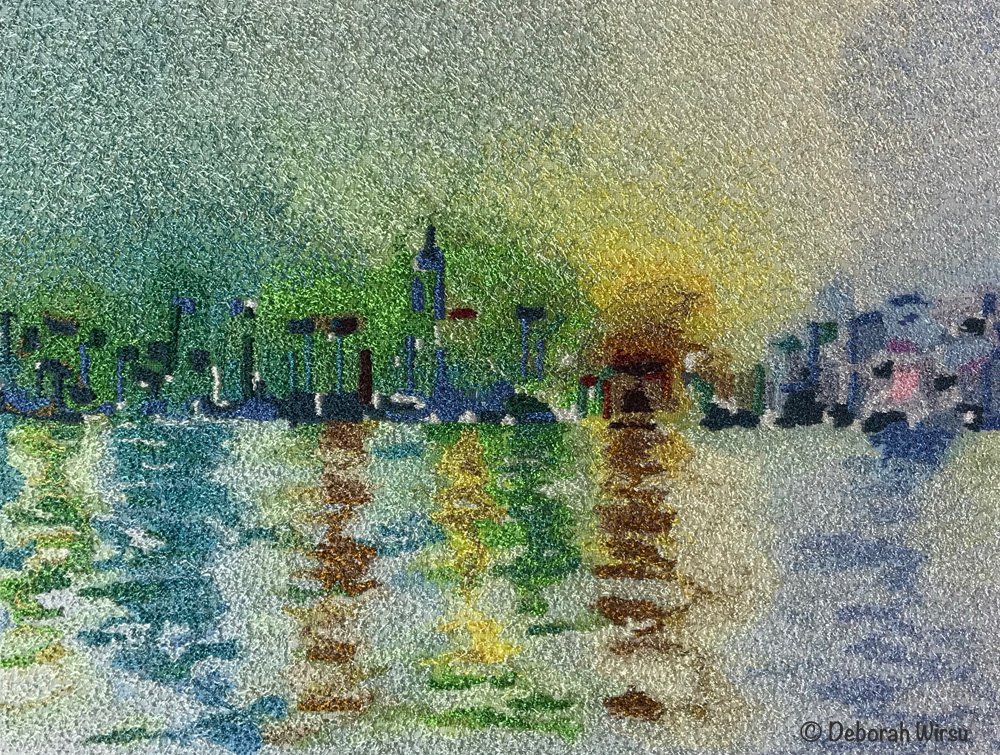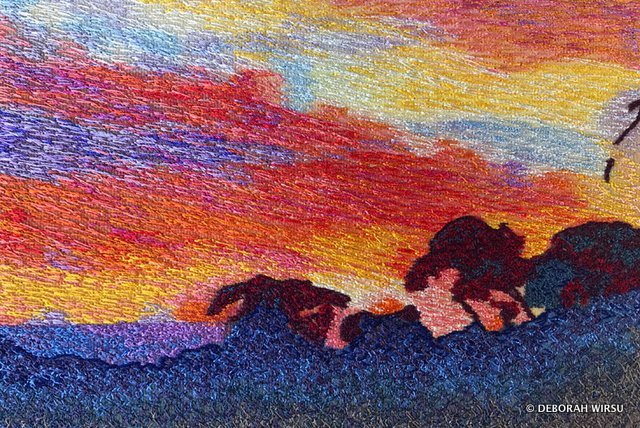
Impressionistic and slightly abstract.
I love to travel – anywhere and anytime! With a particular fondness for Asia, I was due to fly to China next week for another 4-week orchestra/opera tour.
The schedule looked quite hectic, with 15 full opera performances in 15 different cities all over China, in 26 days! At least it was the same program every time!
I was so looking forward to it. There’s something quite exhilarating about working and travelling that way, despite the inevitable exhaustion at the end!
However, the unfortunate situation developing (January/February 2020) around the coronavirus outbreak caused immediate cancellation of the trip.
So I needed to get my oriental ‘fix’ some other way!
OK, I know this particular thread painting doesn’t look particularly ‘oriental’. Still, this impressionistic, slightly abstract interpretation of Hong Kong harbour is a ‘painting’ I’ve longed to make for many years.
Finding your source image
Some 10 years ago or so, during one of my trips to Hong Kong, I took a photo of the city skyline while aboard the Star Ferry that crisscrosses the harbour, linking Kowloon and Hong Kong.
The photo itself is not particularly memorable – I didn’t have a great camera at the time, and to be honest, I’m not really the best of photographers!
![Night Lights- Hong Kong Harbour [source photo] - Deborah Wirsu - Thread Sketching in Action](https://threadsketchinginaction.com/wp-content/uploads/2020/02/Hong-Kong-harbour-at-night-©Deborah-Wirsu.jpg)
But you don’t need to be a great photographer to take pictures that will inspire your creative side, working with fabric and thread.
What I like to capture in my travel photos are memories. Impressions.
I use these impressions to reimagine experiences. This photo brings back special memories for me – the sounds, scents, energy and excitement of Hong Kong; the people, and (Oh my!) the delectable food!
If you feel inspired to create a stitched picture of your travels, flowers in your garden, your pets, children … anything … begin by looking through your photos.
Begin to ‘see’ your photos as art.
Look at your photos with an objective eye. Don’t be critical about composition or light. And definitely ignore the fact that your thumb is covering the corner of the picture!
Perhaps squishy up your eyelids a little and squint at the photos. What do you see?
If you try that with my Hong Kong photo, you’ll likely begin to see it as little more than vertical bands of light.
There are so many ways to use photos as inspiration. You don’t even need to use the whole picture – cropping out one tiny section works exceptionally well. I do that all the time!
So, for the past 10 years, every time I stumbled across this picture in my collection, I thought, Yes, I really need to turn this into a thread painting.
The problem was – How?
At first, I wasn’t working thread paintings as I do now.
My style has evolved and changed a lot over the years.
I think I’m a ‘closet’ painter in the Impressionist style! However, painting with paint and a paintbrush remains, for me, an elusive skill. I so admire people who can paint!
My media are fabric and thread, and thread sketching and thread painting are (primarily) my techniques.
Blending and shading with thread
As I thought about this thread painting, I knew something was holding me back, and that was the darkness.
Yes, I know it’s a night-time photo, so why not simply create a ‘night’ picture? Call me contrary (my mother certainly did, at times!), but I didn’t want to stitch a predominantly dark thread painting!
Looking for something brighter and lighter, I found my solution in radically changing the colour palette.
Sometimes, it’s necessary to use shading to create form, texture or depth and shadows in your thread paintings.
![Journey Through Landscape No15-Night Lights- Hong Kong Harbour[detail]-Deborah Wirsu-Thread Sketching In Action](https://threadsketchinginaction.com/wp-content/uploads/2020/02/Night-Lights-Hong-Kong-Harbour-detail-1.jpg)
At other times, blending and shading create gradations of light.
I’ve learned a lot over the years about mixing colour with thread, and blending and shading to create washes of colour in a picture.
Would you believe, I used over 50 different shades of thread in this piece?
And it measures just 8 ½” x 6 ½”!
I probably could have used fewer shades, but the thing is, once you start really looking at the gradations of colour, it’s hard to resist the temptation.
Sometimes, the most unexpected colours blend together to make the perfect shade.
Unlike mixing liquid paint on a palette, where you can see the new shade evolving, when stitching, it’s not until threads are laid over and under each other that the new effect emerges.
It’s an undeniably fascinating thing to observe!
Choosing a stitch
Like most thread painters, I predominantly use two basic stitch techniques – free motion straight stitch and free motion zigzag stitch – to create my artworks.
Sometimes, I use a mix of the two, as I did with JTL #10 – Nature’s Showtime.

However, this time, for JTL #15 the only stitch used is free motion zigzag stitch.
Use whatever works for you!
Remember my mantra?
There are NO RULES in thread sketching and thread painting.
See the complete JTL series
Check back through Journey Through Landscape series numbers 1 – 14 for a complete overview of where it’s up to.

Hi Deborah
What stunning pictures. What material do you use as your canvas and do you back it with anything?
Hi Barbara – thank you! The backing I use varies from piece to piece. This one is worked on high thread count cotton (similar in weight to ordinary quilter’s cotton) and has a piece of very firm stabiliser underneath. Sometimes I use low-loft batting but did not this time.